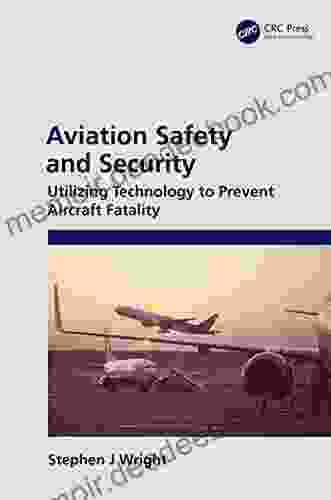Aviation Safety and Security: The Key to Safe and Secure Skies

Aviation is one of the safest modes of transportation, but maintaining a flawless safety record requires constant vigilance and a comprehensive approach to safety and security. Aviation safety focuses on preventing accidents and incidents, while aviation security aims to protect passengers and aircraft from unlawful acts and threats. This guide will delve into the various aspects of aviation safety and security, highlighting the regulatory frameworks, technological advancements, and best practices that contribute to the safety and security of air travel.
5 out of 5
| Language | : | English |
| File size | : | 53766 KB |
| Text-to-Speech | : | Enabled |
| Screen Reader | : | Supported |
| Enhanced typesetting | : | Enabled |
| Word Wise | : | Enabled |
| Print length | : | 278 pages |
Regulatory Frameworks
Aviation safety and security are governed by strict regulatory frameworks established by national and international organizations. These frameworks provide the foundation for setting safety standards, implementing regulations, and ensuring compliance.
- International Civil Aviation Organization (ICAO): ICAO is the specialized agency of the United Nations responsible for setting international standards for aviation safety and security. Its regulations are adopted by most countries around the world.
- Federal Aviation Administration (FAA): The FAA is the U.S. government agency responsible for regulating civil aviation. It develops and enforces safety regulations for aircraft, airlines, airports, and aviation personnel.
- European Union Aviation Safety Agency (EASA): EASA is the European agency responsible for the safety of aviation within the European Union. It develops and implements regulations for aircraft design, certification, and operations.
Technological Advancements
Technological advancements have significantly enhanced aviation safety and security. These technologies provide pilots and air traffic controllers with more accurate and precise information, while also improving the efficiency and effectiveness of safety systems.
- Air Traffic Control (ATC): ATC systems use radar and other technologies to monitor and control aircraft movements, ensuring safe separation and preventing collisions.
- Aircraft Collision Avoidance Systems (ACAS): ACAS technology alerts pilots to potential collisions and provides guidance to avoid them.
- Enhanced Ground Proximity Warning System (EGPWS): EGPWS warns pilots of potential collisions with terrain, obstacles, or other aircraft.
- Airport Security Screening Technology: Advanced screening technologies such as full-body scanners and explosive detection systems help prevent dangerous items from being brought onto aircraft.
Industry Best Practices
In addition to regulatory frameworks and technological advancements, industry best practices play a vital role in enhancing aviation safety and security. These practices are developed through collaboration between airlines, airports, and other stakeholders.
- Safety Management Systems (SMS): SMSs are frameworks that help organizations identify and manage safety risks. They provide a structured approach to safety management and continuous improvement.
- Threat and Error Management (TEM): TEM programs focus on identifying and mitigating threats and errors that could lead to accidents or incidents. They promote a culture of reporting and learning from mistakes.
- Crew Resource Management (CRM): CRM training improves teamwork and communication among flight crew members, reducing the likelihood of human error.
- Passenger Education: Airlines and airports provide passengers with safety and security information, empowering them to be active participants in their own safety.
Challenges and Future Directions
Despite the significant progress made in aviation safety and security, challenges remain and ongoing efforts are essential to maintain and improve safety standards.
- Increasing Air Traffic Volume: Growing air traffic volume presents challenges for ATC and airport capacity, requiring innovative solutions to manage congestion and maintain safety.
- Cyber Threats: Aviation systems are increasingly vulnerable to cyber threats, requiring robust cybersecurity measures to protect against unauthorized access and malicious attacks.
- Unmanned Aircraft Systems (UAS): The proliferation of UAS poses potential risks to manned aviation, necessitating regulations and technologies to ensure safe integration into airspace.
- Human Factors: Human factors, such as fatigue and stress, remain a significant contributor to accidents. Continuous training and support are essential to address these challenges.
Aviation safety and security are paramount to the success and sustainability of the aviation industry. Through a comprehensive approach that encompasses regulatory frameworks, technological advancements, industry best practices, and ongoing research, the industry strives to maintain the highest levels of safety and protect passengers and aircraft in the skies. By embracing innovation, promoting continuous improvement, and fostering a culture of safety, the aviation industry continues to ensure the safety and security of air travel around the world.
5 out of 5
| Language | : | English |
| File size | : | 53766 KB |
| Text-to-Speech | : | Enabled |
| Screen Reader | : | Supported |
| Enhanced typesetting | : | Enabled |
| Word Wise | : | Enabled |
| Print length | : | 278 pages |
Do you want to contribute by writing guest posts on this blog?
Please contact us and send us a resume of previous articles that you have written.
 Novel
Novel Page
Page Chapter
Chapter Story
Story Library
Library E-book
E-book Sentence
Sentence Bookmark
Bookmark Shelf
Shelf Glossary
Glossary Bibliography
Bibliography Foreword
Foreword Annotation
Annotation Manuscript
Manuscript Scroll
Scroll Codex
Codex Bestseller
Bestseller Biography
Biography Autobiography
Autobiography Memoir
Memoir Reference
Reference Character
Character Librarian
Librarian Borrowing
Borrowing Stacks
Stacks Periodicals
Periodicals Study
Study Research
Research Scholarly
Scholarly Lending
Lending Reserve
Reserve Journals
Journals Reading Room
Reading Room Rare Books
Rare Books Special Collections
Special Collections Literacy
Literacy Study Group
Study Group Thesis
Thesis Awards
Awards Textbooks
Textbooks Michael Calvin
Michael Calvin Jean Pierre Corriveau
Jean Pierre Corriveau Gilbert Morris
Gilbert Morris Lea Geller
Lea Geller Steven J Rolfes
Steven J Rolfes David Ellefson
David Ellefson Brendan Bruce
Brendan Bruce Julius Bailey
Julius Bailey Isabelle Tcholakov
Isabelle Tcholakov Zelie Bullen
Zelie Bullen Jilly Cooper
Jilly Cooper David Eagleman
David Eagleman Harinder Sikka
Harinder Sikka Javed Ahmad
Javed Ahmad Daniel Waitzman
Daniel Waitzman John Took
John Took Matthew P Coleman
Matthew P Coleman Mary Ann Clark
Mary Ann Clark Gail Green
Gail Green T Rae Mitchell
T Rae Mitchell
Light bulbAdvertise smarter! Our strategic ad space ensures maximum exposure. Reserve your spot today!

 Adrien BlairEscape into the Enchanting Embrace of Standalone Enemies-to-Lovers Holiday...
Adrien BlairEscape into the Enchanting Embrace of Standalone Enemies-to-Lovers Holiday...
 Vincent MitchellThe Artist Who Revolutionized Painting: Pablo Picasso and the Birth of Cubism
Vincent MitchellThe Artist Who Revolutionized Painting: Pablo Picasso and the Birth of Cubism
 George Bernard ShawMastering Conversational AI: A Comprehensive Guide to Building Complex...
George Bernard ShawMastering Conversational AI: A Comprehensive Guide to Building Complex... Ivan CoxFollow ·14.2k
Ivan CoxFollow ·14.2k Cody BlairFollow ·7.6k
Cody BlairFollow ·7.6k Matt ReedFollow ·2.1k
Matt ReedFollow ·2.1k Grant HayesFollow ·2.8k
Grant HayesFollow ·2.8k Bret MitchellFollow ·9.2k
Bret MitchellFollow ·9.2k Ray BlairFollow ·3.8k
Ray BlairFollow ·3.8k Samuel WardFollow ·10.6k
Samuel WardFollow ·10.6k Aron CoxFollow ·4.8k
Aron CoxFollow ·4.8k

 Vernon Blair
Vernon BlairHow to Get a Woman to Pay for You: A Comprehensive Guide...
In the modern dating...

 Levi Powell
Levi PowellPrinciples and Theory for Data Mining and Machine...
Data mining and machine learning are two...

 Andrew Bell
Andrew BellMirrors For The Mind: Milestones In Discovery And...
Mirrors have been a part of human history...

 Alec Hayes
Alec HayesDelving into Natural Language Processing with Java and...
Natural Language Processing (NLP) is an...
5 out of 5
| Language | : | English |
| File size | : | 53766 KB |
| Text-to-Speech | : | Enabled |
| Screen Reader | : | Supported |
| Enhanced typesetting | : | Enabled |
| Word Wise | : | Enabled |
| Print length | : | 278 pages |










